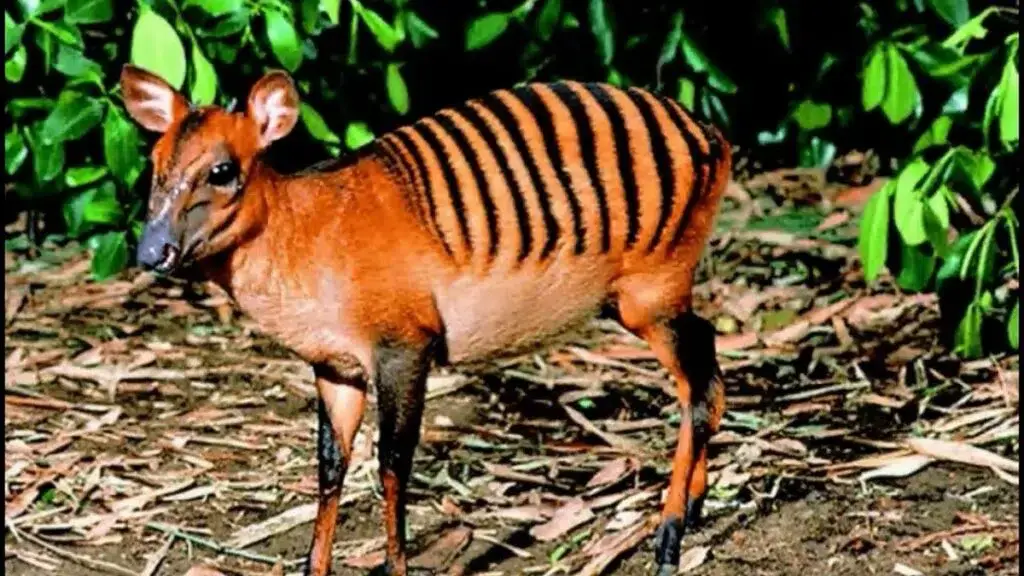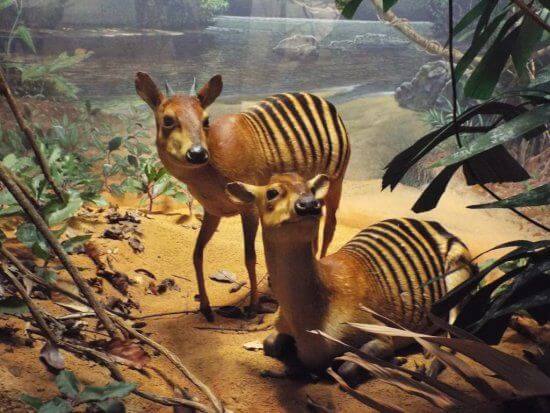Meet the Zebra Duiker

Although its name gives you a clue as to what it will look like, the zebra duiker has nothing to do with the equids that give it its name. However, its coat is striped like a zebra’s, at least on one part of its back.
This delicate and adorable antelope is difficult to locate, but it’s still endangered. That’s why the best weapon for its conservation is to get to know it a little better. In this space, you’ll find everything you need to know about this small animal and its characteristics. Don’t miss it.
Classification and description
The zebra duiker goes by the scientific name of Cephalophus zebra. It’s a small antelope species that belongs to the bovine family, just like cows, gazelles, goats and sheep.
As you can see in its photo, its coat is a coppery brown with a slight darkening on the face, limbs, and tail. The most characteristic feature of its appearance, however, are the black and white stripes on its back.
Females are larger than males. While they’re about 45 centimeters tall (1.5 feet) and weigh up to 20 kilograms (44 pounds), males are only 40 centimeters (1.3 feet) and weigh 15 kilograms (33 pounds). This difference is thought to be due to the long gestation period of females.
Habitat of the zebra duiker
The main geographic range of this antelope is in the mid-western part of the African continent. Specifically, it can be found in isolated regions of Sierra Leone and Côte d’Ivoire, as well as in Liberia.
In fact, it’s endemic to the western Guinean rainforest. It inhabits mountainous areas, primary forests and lowlands, hence its longer hind limbs, allowing it to move freely through tall vegetation.
What does the zebra duiker feed on?
The zebra duiker is a strict herbivore, and feeds mainly on fruits and foliage. Within their diet, you will find leaves, buds, and seasonal fruit that falls to the ground (as they aren’t tall enough to pick it from the branch).
They often take advantage of what other animals, such as bats or birds, drop from the trees when feeding.
In addition, the thickening of their nasal and frontal bone allows them to open hard-shelled fruits, which gives them an advantage over other species that they share the habitat with. It has also been observed to consume small rodents on very rare occasions, but not enough is yet known about this fact to remove the herbivore title.
Reproduction

Zebra duikers breed once a year. At each birth, they’ll give birth to only one calf, but it’s born well developed and weighs about 1.5 kilograms (3.3 pounds). In fact, gestation lasts 221 to 229 days (about 7 months), a very long period for an animal of this size. This, as mentioned at the beginning, explains the larger size of the females.
The offspring grow at an astonishing speed during the lactation period. They can gain about 94 grams (nearly 4 oz) of weight per day during the first 10 days of life. After that, the growth rate decreases markedly.
Females reach sexual maturity at 9-12 months of age. Males a little later, at 12-18 months. Once they’re able to reproduce, they produce odorous secretions through various glands in the body, especially the males.
At each breeding season, pairs that have already bred are thought to seek each other out again and rarely change partners.
Behavior
The zebra duiker is a solitary animal with nocturnal habits. They’re only found grouped in pairs during the breeding season, since parental care is shared and the young have a long learning period during which they need their parents.
In captivity, diurnal habits have been reported in this species, but the change is detrimental to their health.
Conservation status
When consulting the International Union for Conservation of Nature (IUCN) for their conservation status, we can see that they’re in a vulnerable status (VU). This is mainly due to deforestation of its habitat, indiscriminate hunting for meat and fur, and loss of habitat due to exploitation of the land for economic activities.
Like many other endangered species, the zebra duiker is specifically adapted to its environment and wouldn’t be able to survive in other habitats. This is a handicap in protecting them, as they need to be protected from exploitation.
The wild population is estimated at 9500 mature adults and is declining.
Currently, the last strongholds of this antelope are in the protected parks of Sierra Leone and Liberia, where captive-bred specimens have been successfully released. However, as long as their natural habitat continues to be fragmented and destroyed, there’s no hope for the recovery of the zebra duiker.
All cited sources were thoroughly reviewed by our team to ensure their quality, reliability, currency, and validity. The bibliography of this article was considered reliable and of academic or scientific accuracy.
- Grupo de especialistas en antílopes de la SSC de la UICN. 2016. cebra Cephalophus . La Lista Roja de Especies Amenazadas de la UICN 2016: e.T4153A50184648. https://dx.doi.org/10.2305/IUCN.UK.2016-1.RLTS.T4153A50184648.en. Consultado el 30 de mayo de 2022.
- Cephalophus zebra (zebra duiker). (s. f.). Animal Diversity Web. Recuperado 30 de mayo de 2022, de https://animaldiversity.org/accounts/Cephalophus_zebra/#conservation_status